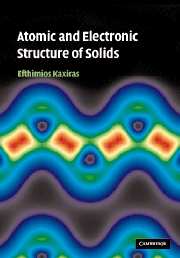Book contents
- Frontmatter
- Contents
- Preface
- Acknowledgments
- I Crystalline solids
- II Defects, non-crystalline solids and finite structures
- III Appendices
- Appendix A Elements of classical electrodynamics
- Appendix B Elements of quantum mechanics
- Appendix C Elements of thermodynamics
- Appendix D Elements of statistical mechanics
- Appendix E Elements of elasticity theory
- Appendix F The Madelung energy
- Appendix G Mathematical tools
- Appendix H Nobel prize citations
- Appendix I Units and symbols
- References
- Index
Appendix A - Elements of classical electrodynamics
Published online by Cambridge University Press: 06 July 2010
- Frontmatter
- Contents
- Preface
- Acknowledgments
- I Crystalline solids
- II Defects, non-crystalline solids and finite structures
- III Appendices
- Appendix A Elements of classical electrodynamics
- Appendix B Elements of quantum mechanics
- Appendix C Elements of thermodynamics
- Appendix D Elements of statistical mechanics
- Appendix E Elements of elasticity theory
- Appendix F The Madelung energy
- Appendix G Mathematical tools
- Appendix H Nobel prize citations
- Appendix I Units and symbols
- References
- Index
Summary
Electrodynamics is the theory of fields and forces associated with stationary or moving electric charges. The classical theory is fully described by Maxwell's equations, the crowning achievement of 19th century physics. There is also a quantum version of the theory which reconciles quantum mechanics with special relativity, but the scales of phenomena associated with electromagnetic fields in solids, that is, the energy, length and time scale, are such that it is not necessary to invoke quantum electrodynamics. For instance, the scale of electron velocities in solids, set by the Fermi velocity νF = ħkF/me, is well below the speed of light, so electrons behave as non-relativistic point particles. We certainly have to take into account the quantized nature of electrons in a solid, embodied in the wavefunctions and energy eigenvalues that characterize the electronic states, but we can treat the electromagnetic fields as classical variables. It is often convenient to incorporate the effects of electromagnetic fields on solids using perturbation theory; this is explicitly treated in Appendix B. Accordingly, we provide here a brief account of the basic concepts and equations of classical electrodynamics. For detailed discussions, proofs and applications, we refer the reader to standard textbooks on the subject, a couple of which are mentioned in the Further reading section.
- Type
- Chapter
- Information
- Atomic and Electronic Structure of Solids , pp. 515 - 529Publisher: Cambridge University PressPrint publication year: 2003

